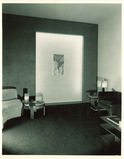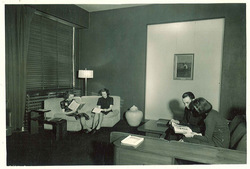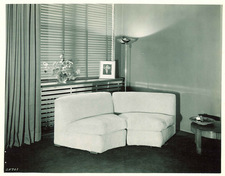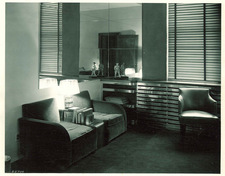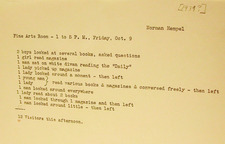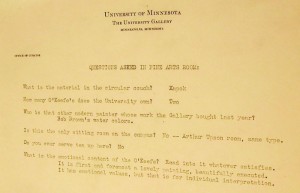In building upon President Lotus Coffman’s initial intentions with the “fine arts experiment” at the University, in the early years the Gallery provided not only exhibition and art rental in order to improve the “cultural aspects” of the student population, but also a room of respite in order for students to be exposed to art and culture.
Documentation included in Box 101, which includes Ruth Lawrence’s early correspondence and administrative papers, creates a picture of what the “Fine Arts Room” was like and the processes followed to maintain it.
Georgia O’Keeffe: Oak Leaves, Pink and Grey
The Room was featured in a 1935 edition of School and Society in an article titled, “An Experimental Arts Room at Minnesota,” prompting an inquiry to Ruth Lawrence from a reader, C.H. Bennett. Lawrence, responding to the inquiry, provides an additional description of the room’s atmosphere and design, which also compliments the black and white photographs contained in the photograph collection of the University Archives:
“The room is modern in design. A blue and off white color scheme is carried throughout, two walls blue and two walls and the ceiling off white. The furniture is all modern; the lines are horizontal. The windows have blue venetian blinds and heavy blue drapes which drop to the floor. At one end of the room is an alcove, indirectly lighted, in which we exhibit one masterpiece of modern painting. The corner of the opposite wall is mirrored in such a way as to afford a transition from the blue wall to the off white one. Besides the lighting in the alcove there are many modern designed lamps to give that added touch that makes the room homelike.”
“Everyone seems to feel that the room is fulfilling adequately the hope that it will become an art sanctuary. I believe an incident which happened when we opened the room will illustrate this. The evening before the opening reception, I was sitting in the room, giving it a last appraisal and criticism, when one of my employees came in to ask me a question. He progressed to the center of the room, stood still a moment, and then, with a hasty apology, carefully carried his cigarette to the door, and stamped it out saying that it was nothing short of sacrilidge to smoke there.”
The care and upkeep of the Room was tasked to the federal student workers employed at the Gallery. In “Instructions to Federal Students,” a complete description of the maintenance of the room is described,
“The Fine Arts Room is to be cleaned thoroughly 3 times a week. By cleaning “thoroughly” we mean that the rug is to be vacuumed, the venetian blinds dusted, the furniture dusted, the mirrors washed, the metal grills polished, etc. Every day however, the cabinets are to be dusted and should the rug need vacuuming, that is to be done also. We shall try to arrange it so that it is the duty of certain girls to do cleaning, but it is every girl’s responsibility to see that the room is in good shape at all time.”
The instructions also describe the behaviors to follow within the Room, which was monitored by “hostesses,” “Hostesses are not to study while they are on duty in this room. They are to sit quietly, reading the art books and magazines and taking the attendance. Visitors are not to smoke, study, or converse in loud tones. Also, lounging or napping on the part of either the visitors or hostesses is not permitted.”
The instructions further indicate, “Daily attendance blanks are to be taken from the office by the person opening the room for the day. They are to be left in the room for subsequent entries by other hostesses and turned in to Room 318 when the room is closed.”
Take a look at the attendance taken, and list of questions asked about the Fine Arts Room:
